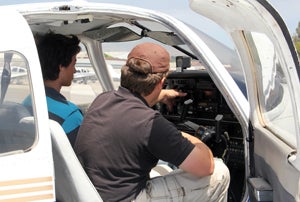As a flight instructor, I find it particularly difficult to read about airplane accidents – fatal or not – that could have been prevented by better choices and, in some cases, better training. Flight instructors need to focus less on teaching their students to pass the FAA test and more on becoming good pilots that make good decisions. An organization called SAFE (Society of Aviation and Flight Educators) and several aviation companies are focusing their efforts on revamping flight training to teach safer pilots.
SAFE provided an update on its initiative to reform flight training at the EAA AirVenture last week in Oshkosh, Wisconsin. SAFE’s Bob Wright explained that several groups have been asked to provide responses by September 30 on six comprehensive training reform projects identified at the SAFE Pilot Training Reform Symposium, which was held in May of this year.
Wright said that the projects are designed to solve two main issues that have been identified – the stagnating safety record and student pilot retention. The two issues are in some ways tied, Wright said, as an improved safety record could increase the attractiveness of aviation to the general public. AOPA claims only 20-30 percent of student pilots who begin their flight training successfully complete their licenses.
The responses to the training reform projects will serve as a basis for recommendations to the FAA to revise AFS-800 and AFS-600. But while the ultimate goal is to revise FAA regulations, this could take years to complete. Fortunately the industry is not waiting to take action until the regulatory changes have been implemented. As an example, a new FBO and flight training facility called SkyPort is opening this fall in San Marcos, Texas. RedBird Flight Simulators has partnered with King Schools and Cessna Aircraft Company to create an “innovative aviation laboratory” which will serve as a “test bed for innovative hardware, software, business processes and ideas with the goal of revitalizing general aviation.”
The new facility will implement an increased use of simulation. While approved simulators only count toward 2.5 hours of the required 40 hours to qualify for a private pilot’s license, the SkyPort teams hopes that the FAA will increase that number once they realize just how much good these devices can do.
It will be great if the FAA changes those regulations. But to me, it doesn’t really matter how many simulator hours count toward the rating. The average time to complete the private pilot’s license is 60-70 hours anyway. So if the if the instructor feels that he or she can produce a better, safer pilot using five hours in a simulator, what difference does it make? The goal should be to produce safe aviators who are trained to make good decisions that will keep them flying for many years to come. Whether you as an instructor are training a student for an FAA certificate or rating, or you’re just doing a simple BFR, don’t wait for new rules or testing methods to be implemented at the FAA level. Focus on helping your student learn to fly safely in the real world instead of just getting them legally qualified to fly.
